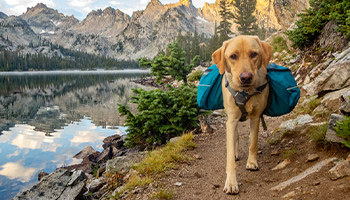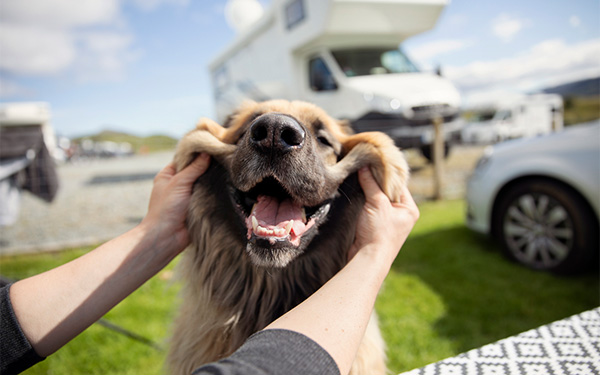If you’re like most dog owners, you probably want to bring your furry friends along with you no matter where you go—including your RV trips. Thankfully, most rigs are big enough to accommodate a few extra paws. However, RVing with dogs does come with a few challenges and responsibilities you must be aware of and prepare for. So, whether you’re a seasoned RVer or a new adventurer RVing with dogs for the first time, this blog post will help you plan (and enjoy) your upcoming trip. Ready, set, bark!
Preparing Your Dog for an RV Trip

Before heading out on the road, you must do a bit of preparation. This means getting your dog accustomed to the RV environment and finding space within your rig where your pup can securely rest between campsites.
To get your dog accustomed to the RV, we recommend letting them spend time in it while it is parked. This will help your dog familiarize itself with the different sights and sounds of the RV, calming any nerves they may have. You can also practice some basic routines in the RV, such as where to eat and sleep, to further boost their comfort and confidence in the rig.
For the best experience, try to recreate your dog’s sleeping situation as best as possible inside your RV. For example, if they have a bed that fits well in your rig, bring it with you instead of buying a new one. If they usually sleep at the foot of your bed, allow for the same on your RV trip.
When your dog isn’t resting, you may want to allow them to sit on your lap between destinations. However, doing so can put you and your dog’s safety at risk. Instead, purchase a seatbelt leash attachment to securely fasten your co-captain in their seat. If you bring a dog crate with you, ensure it is secured down to prevent movement.
Packing Your Doggy Essentials
When RVing with dogs, your goal is to make the journey as comfortable as possible for your pet. Just like we have camping essentials, there are a few doggy items you don’t want to leave home without. For starters, pack extra food and fresh water to keep your dog fed in case of a breakdown or if the trip lasts longer than you initially expected. In addition, having a laminated card with your dog’s identifying information, vaccination record, and microchip details may be helpful during an emergency.
Here’s a list of basic dog essentials to bring with you on an RV trip:
- Two sets of leashes, collars, and harnesses (daily use + backup).
- Plenty of food and fresh water, including carrying cases.
- Food and water bowls. Look for collapsible options to take on hikes.
- A dog backpack to carry extra treats and food when out exploring.
- Your pup’s favorite toys and treats.
- Potty bags and cleaning supplies to clean up after your dog.
- Bedding and sleeping materials.
- Any medication your dog may have.
- A basic dog first aid kit with essentials plus tweezers, dog boots, an emergency blanket, wraps, and a pet first aid book.
Finding a Dog-Friendly Campsite
Finding destinations that welcome dogs with amenities for them is just as important as packing the right gear.

There’s nothing worse than arriving at a new location only to see a “no dogs allowed” sign. Sure, spontaneous trips are great. But when traveling with our furry friends, planning ahead will ensure you and your dog have an enjoyable experience.
Regardless of the trip you’re planning, always research destinations online to learn more about their pet policies and leash laws. While many national and state parks allow leashed dogs in specified areas, not every park or campsite does. Always follow local leash laws, as failing to do so could result in hefty fines or cause injury to your dog. You can also use sites such as Go Pet Friendly or Bring Fido to discover additional dog-friendly adventures when traveling somewhere new.
Keeping Your Dog Happy While RVing

The last step to any successful RV trip with your dog is to keep them happy and healthy. The easiest way to do this is by always having them at your side and incorporating exercise into your schedule. Although you may love spending time in your RV, your dog likely prefers having space to run around. If you need to stop for a restroom break, use the opportunity to squeeze in some playtime and do so often. And as a reminder, you should never leave your pup unattended in a closed or hot vehicle.
When out exploring, there are a lot of hazards your pup may not be aware of, so keeping them on a leash will help avoid any accidents. For one, you may run into some wildlife on your travels. In these scenarios, having control over your dog is vital. Additionally, nature is full of toxins or smaller animals that can hurt your dog. Always watch your dog’s behavior and look for symptoms such as excessive panting, drooling, or inactivity that may indicate something is wrong.
Finally, give the vet a visit before going on the trip. Some facilities may require proof of rabies vaccination when visiting, so this could be a good time to obtain physical copies of your pet’s health records. And if you need to see a vet on the road, having copies will give them your dog’s health history. If your dog isn’t already microchipped, we recommend inquiring about your options, especially if you’ll be taking frequent trips with your dog.
Keep Everyone Protected
No matter who you bring along with you on your travels, having the proper insurance will keep everyone protected. Embrace offers comprehensive and personalized coverage options for your furry best friend. And unlike a standard auto policy, RV insurance can include additional coverage types that cover a broader range of situations you may find yourself in, such as vacation liability or roadside assistance. To learn more about the RV insurance options for your rig, call our RV insurance specialists at (866) 501-7335.
The information in this article is obtained from various sources and is offered for educational purposes. Furthermore, it should not replace manuals or instructions provided by the manufacturer or the advice of a qualified professional. No warranty or appropriateness for a specific purpose is expressed or implied.
